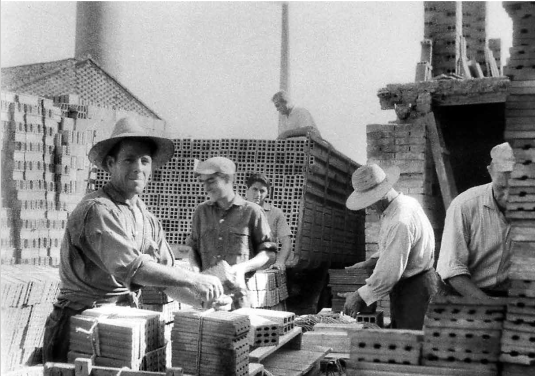In the shadow of the chimneys

In 2012, the Alfonso el Viejo Centre for Regional Studies and Research suggested I write a script that would tell the story of Els Rajolars a Oliva; an exciting story full of human experiences that still today is not finished, since the brick industry survives – transformed, of course – in other industrial aspects.
I wanted to deal with this story starting from the moment of maximum splendour in 1950, when Els Rajolars had another source of local income in the orange, making Oliva one of the populations with the highest GDP in all of Spain, and which transformed our town, as I understand it, into a city. The strength of an industry that had been here all along transformed the urbanism of our village in a definitive way.
There are many who claim to have been familiar with the Moorish furnaces of their ancestors, but the industrial change to the Hoffman furnace was definitive. Its implementation was always accompanied by the classic chimneys that today constitute one of the most characteristic symbols of our town and especially of the Sant Francesc neighbourhood.
My research was directed towards different aspects, I intended to cover everything and make it accessible to everyone; therefore the most important thing was the personal aspect with interviews of the people who were, and still are in some cases, involved in the tile sector. At that moment I realized the wealth of human qualities present in the village, because in all the interviews at some point stories of misery and glory, of effort, survival and overcoming would surface, both regarding the people born in Oliva and those who arrived from other areas of the nation to enrich our village.
I would not want to mention any specific story here because there are so many – some so exciting as to constitute veritable epics that in the United States would be the subject of films and television series. But it should be mentioned that the growth of the familiar neighbourhood of Sant Francesc, where a large part of the factory workers lived, contains many stories of achievements and solidarity between the workers who came from outside and those who already lived here, since in the beginning, when they arrived, the workers (and often their families) lived inside the factories, near the furnaces to be hot. Slowly, however, the new workers integrated into Oliva and many houses in the area of the Senda de los Ladrones were built on Sundays with bits and pieces left over from the material of Els Rajolars; and I imagine that they grew up among all the neighbouring ones in a festive, almost tribal way, the new owners full of excitement about making their own home.
Another story that also deserves to be told is that of the creation, at a certain time in the early 60s, of an association of Oliva bricklayers that lasted more than a decade. In addition to the economic and operational issues that this entity oversaw, it also contributed with material to the construction of the Oliva nursing home, one of the most characteristic and needed buildings in our village, another example of participation and humanity.
In short and by way of a conclusion, I don’t think it would be wrong to say that the neighbourhood of Sant Francesc is a neighbourhood with a particular personality, a classic neighbourhood that has grown through effort, tears, smiles… a mixture of people from all over in the shadow of the impressive chimneys that in a symbolic way protect its inhabitants and its peculiar feel.
Perhaps my project will be taken up at another time, by me or by another person; in any case, although I ultimately only focused on Els Rajolars, it is clear that the history of the Sant Francesc neighbourhood deserves to be told.
I would like to thank the following people for their participation, many do not live in the neighbourhood, but all of them love it: David Cots, Domingo Arlandis, Vicent Vila, Don Santiago, Sivera, José Antonio Navarro Cerdà and his uncle, Inma Seguí, Salvador Tercem, Miguel Pons, Pepa Chesa, Vicent Aguilar, Luis Chorro, Emilio Andrés, Vicent Llopis, José Lucas, Felipe Peña, Gracia López Patiño, Manu lbañez, Gisbert Santonja, Emili Moscardó and Joan Ramon Morell.
